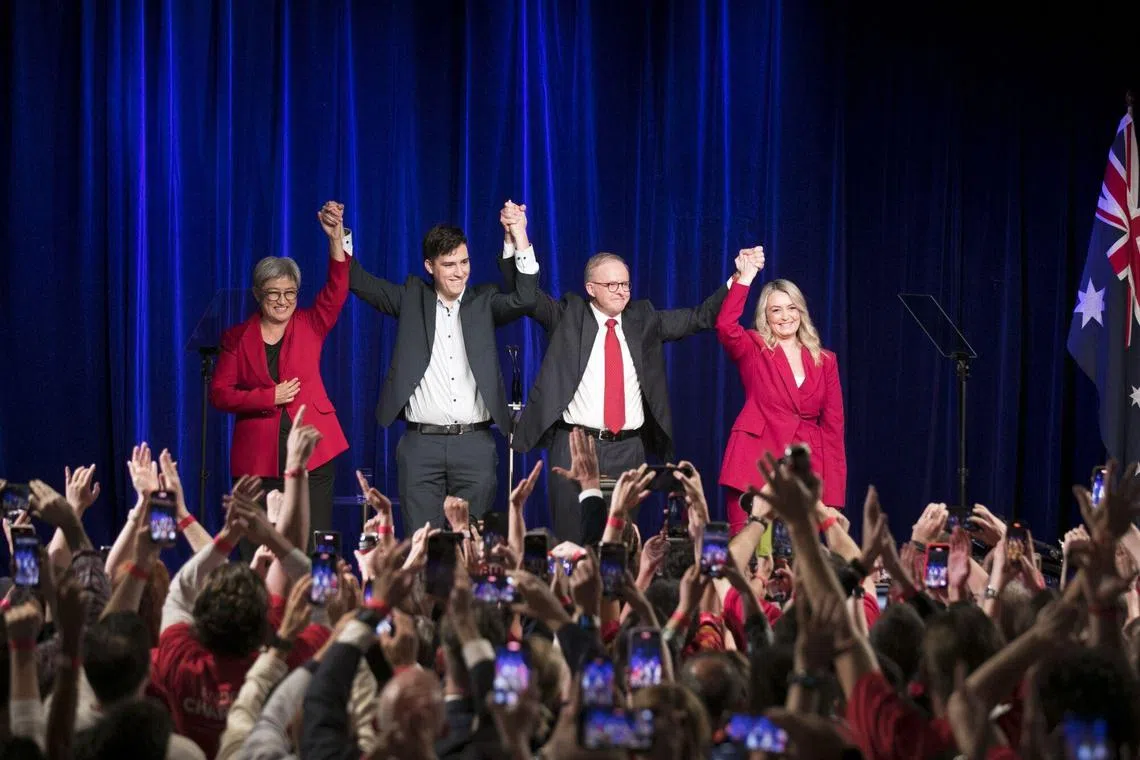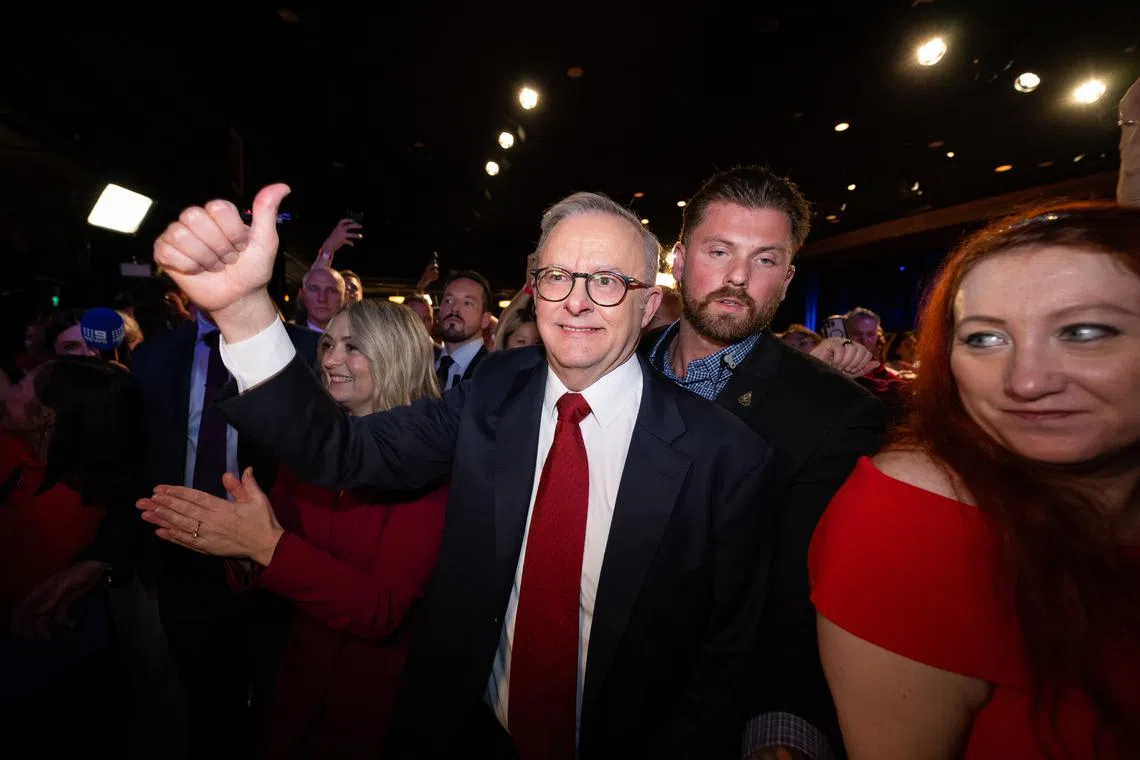News analysis
Australia hands PM Anthony Albanese second term in flight to safety from Trump woes
Sign up now: Get insights on Asia's fast-moving developments

Australian PM Anthony Albanese (second from right) with his son Nathan Albanese, partner Jodie Haydon (right) and foreign minister Penny Wong on May 3.
PHOTO: BLOOMBERG
Follow topic:
SYDNEY – Mr Anthony Albanese’s spectacular win in Australia’s election on May 3 has redrawn the nation’s electoral map as voters opted for stability in the face of Mr Donald Trump’s disruptive global leadership.
Just five days after Mr Mark Carney’s Liberal Party retained government in Canada, Mr Albanese led Australia’s ruling Labor Party to a historic victory.
With 77 per cent of the vote counted as at May 4, Labor is on track to defeat the Liberal-National Coalition by 55 per cent to 45 per cent, compared with 52 to 48 per cent at the last election in 2022.
This bucks the historical trend of Australia’s first-term governments, which typically win a second term but with fewer votes and seats as their honeymoon period ends.
Labor has dramatically increased its majority and has already secured 86 of 150 seats in the House of Representatives – where a majority is required to form government – with 13 seats still too close to call. The Coalition has won 39 seats, while independents and minor parties have won 12 seats.
The ruling centre-left party was on track to lose the election in Australia – until the inauguration of Mr Trump in January.
But Mr Trump’s decision to impose tariffs on Australia, one of the US’ closest allies, and the doubts he has cast about traditional US relationships, appeared to have prompted voters in Australia to avoid change and shun centre-right leaders who had adopted Trump-style policies.
Opposition leader Peter Dutton, who had proposed cutting the public service and limiting work-from-home for public servants, suffered a humiliating defeat in his own seat.
The same patterns played out in Canada’s federal election in late April. The centre-left Liberal Party, initially trailing the Conservatives by over 20 points, experienced a dramatic turnaround after Mr Trump’s threats to impose tariffs and annex Canada.
Discussing Labor’s win, Australia’s Treasurer Jim Chalmers said on May 4: “What’s happening, particularly between the US and China, does cast a dark shadow over the global economy.
“We need to have the ability, and we will have the ability, to manage that uncertainty.”
But the unpopularity of Mr Trump’s leadership – which is fuelling concerns about the international economic outlook – was not the only reason for Mr Albanese’s stunning win.
His victory also indicates the possible end of the recent anti-incumbent voting trend in elections triggered by rising inflation in countries such as the United States, Japan and Britain.

Australian PM Anthony Albanese greets the crowd after giving a speech at the Labor Election Night function in Sydney, on May 3.
PHOTO: EPA-EFE
In Australia, voters appear to have been persuaded by Labor that the worst of the recent inflation spike has ended and that better times lie ahead. Its message was buttressed by the Reserve Bank of Australia’s decision in February to cut interest rates and end its record run of rises. Indeed, the bank is expected to again cut rates on May 20.
Mr Dutton, the Coalition leader, had echoed Mr Trump’s campaign rhetoric and asked voters whether they were better off now than three years ago. The answer, for almost all voters, was that they were not, as grocery prices, electricity prices, housing prices and rents have surged.
Still, Labor succeeded in persuading voters that it had a better plan for the future. It promised a modest tax cut of A$5 (S$4.20) a week from next year. Surprisingly, the Coalition, which typically presents itself as the party of lower taxes, rejected the policy and instead promised a 25 cent cut in petrol prices for a year.
Mr Albanese also offered respite to students on their student loans, promised to boost childcare subsidies and spend more on healthcare.
Voters may have been angry at the government over the cost of living pain – and Mr Albanese’s approval ratings are low – but they appeared to believe these modest handouts and a period of political stability were preferable to the risk of opting for change.
The Coalition, whose promise to build nuclear reactors was soundly rejected by voters, is on track for one of its worst-ever election results.

Supporters react during the Australian Labor Party election night event in Sydney, on May 3.
PHOTO: BLOOMBERG
In his victory speech, Mr Albanese appeared to be referring to Mr Trump as he repeatedly called for greater respect in politics. And he almost certainly was alluding to the US when he said that Australians “do not need to beg or borrow or copy from anywhere else”.
“We do not seek out our inspiration overseas,” he said. “We find it right here in our values and in our people.”
Prime Minister Albanese, who had only a narrow majority after the 2022 election, now has a strong mandate to impose his will on the country. Despite this, Australia’s course is unlikely to change radically.
Mr Albanese has been a cautious leader so far. He has wholeheartedly embraced a decision by the previous Coalition government to acquire nuclear-powered submarines as part of the Aukus security pact with the US and UK, partly due to concerns that he would otherwise be attacked as weak on national security.
He has pursued stronger carbon emissions targets than the Coalition but is still far from reaching the party’s target of sourcing 82 per cent of power from renewables by 2030, up from the current level of about 40 per cent.
He strongly believes that Labor supports greater fairness and equality and support for the vulnerable. Indeed, his mantra throughout the campaign was “No one held back and no one left behind”.
Above all, Mr Albanese, who has spent his adult life in the Labor Party and has been an MP for 29 years, is a canny political operator. And his primary goal, as a Labor devotee, has been to ensure that the party wins and holds onto power.
As prime minister, he has been wary of taking risks or bold steps that might alienate voters. He has preferred a gradualist approach and signalled that he wants to change the nation over multiple terms, rather than in a single term of Parliament.
And this appears to suit Australians, who have clearly rejected the disruptiveness of Mr Trump.
As it stands, Mr Albanese has now set Labor up to win a third term and rule for at least six more years – as long as the party maintains the unity and discipline it did in his first term.
Jonathan Pearlman writes about Australia and the Pacific for The Straits Times. Based in Sydney, he explains matters on Australia and the Pacific to readers outside the Oceania region.


